If you are looking for the best chest workout at home with dumbbells, then you are in the right place.
Here, we discuss the best chest workout that you can do at home or the gym with the help of dumbbells to build muscle mass and strength.
Only an adjustable bench and dumbbells are required for a workout setup at home.
Using dumbbells to train your chest is easier on your wrist, elbow, and shoulder joints because they give you more movement freedom.
Beginners and advanced lifters can use dumbbells to build a strong foundation of strength.
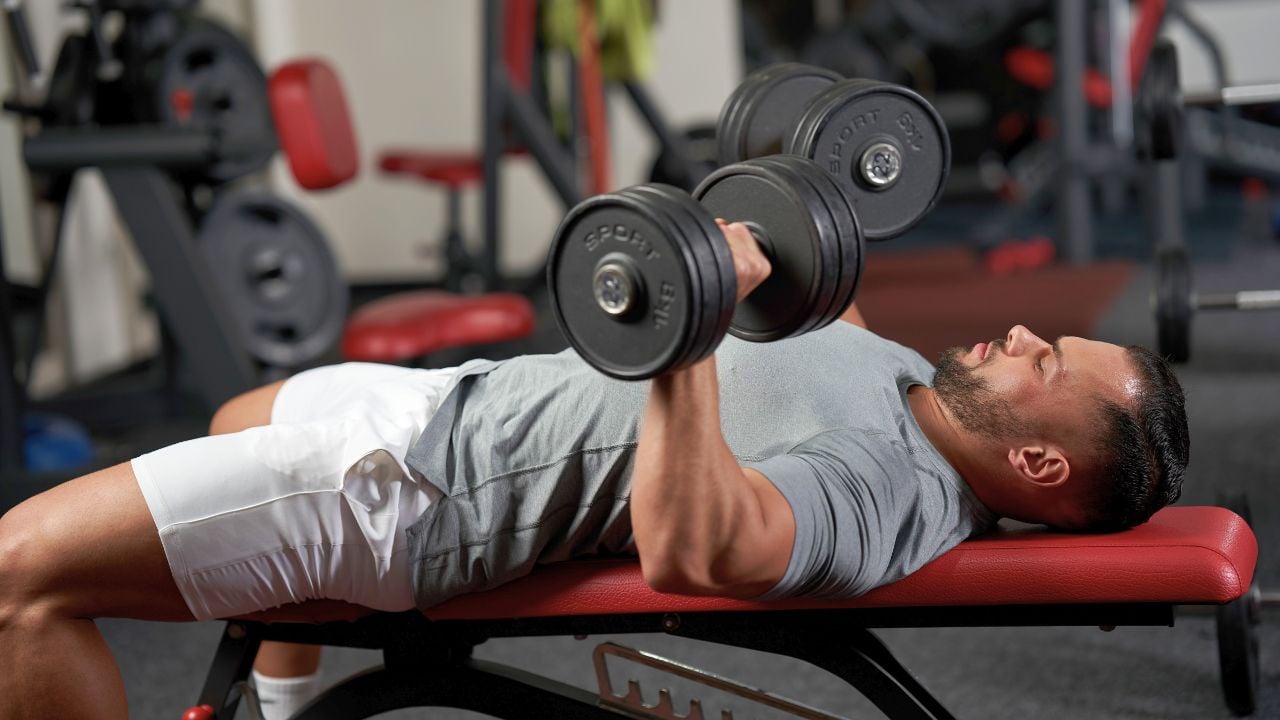
- What is the Best Dumbbell Chest Workout? Compound or Isolation Exercises
- Compound Exercises
- Isolation exercises
- 10 Best Dumbbell Chest Exercises
- 1. Dumbbell Bench Press
- 2. Incline Dumbbell Press
- 3. Decline Dumbbell Press
- 4. Dumbbell fly
- 5. Incline Dumbbell Fly
- 6. Decline Dumbbell Fly
- 7. Dumbbell Pullover
- 8. Dumbbell Squeeze Press
- 9. Incline Bench Dumbbell Pullover
- 10. Standing Upward Chest Fly
- Bonus: Dumbbell Push-Ups
- How to Build a Bigger Chest with Dumbbells
- 1. Mix Up Your Moves
- 2. Increase Weight Progressively
- 3. Focus on form
- 4. Add Variety
- 5. Training Plan As Per Your Goal
- 6. Add Intensity
- 7. Give Your Muscles Time to Recover and Proper Nutrition
- Dumbbell Chest Workout Plan
- Workout Routine For Beginner
- Routine For Intermediate
- Routine For Advance
- Know More About Chest Muscles
- Pectoralis major
- Pectoralis minor
- FAQs
- What are some other dumbbell exercises for the chest besides the bench press?
- How heavy should the dumbbells be for chest exercises?
- How often should I do dumbbell chest exercises?
- Are dumbbell chest exercises suitable for beginners?
- Takeaways
What is the Best Dumbbell Chest Workout? Compound or Isolation Exercises
Dumbbells offer targeted training for building a bigger, stronger chest. To maximize muscle growth (hypertrophy), focus on exercises that work different areas of your chest muscles.
There are two basic kinds of dumbbell chest workout, compound exercises and Isolation.
Compound Exercises
Compound exercises work for multiple muscle groups simultaneously, maximizing your workout efficiency.
The dumbbell chest press and dumbbell push-ups are examples of a compound exercise that works the chest, shoulders, and triceps.
Isolation exercises
On the contrary, isolation exercises target a specific muscle group in isolation.
The dumbbell chest fly is an example of an isolation exercise that targets the chest muscles exclusively.
These exercises are great for targeting weak or lagging muscle groups and for building muscle definition and separation.
10 Best Dumbbell Chest Exercises
Want a bigger, stronger chest? Build the foundation with heavy weights, then sculpt the details. Any chest exercises that you can do with a barbell can be replicated with dumbbells.
Here are the 10 best dumbbell exercises to build a massive, well-shaped chest. Some of them are old-fashioned, but they have a new twist that makes them even better!
1. Dumbbell Bench Press
The dumbbell bench press is a classic exercise that targets your chest muscles, as well as your triceps and shoulders/
The Barbell Bench Press does not have a full range of motion, which the dumbbell bench press can overcome.
The dumbbell bench Press adds the extra range of motion at the top for a complete Chest development. Moreover, Dumbbells demand better coordination, forcing the stabilizing muscles to assist as well.
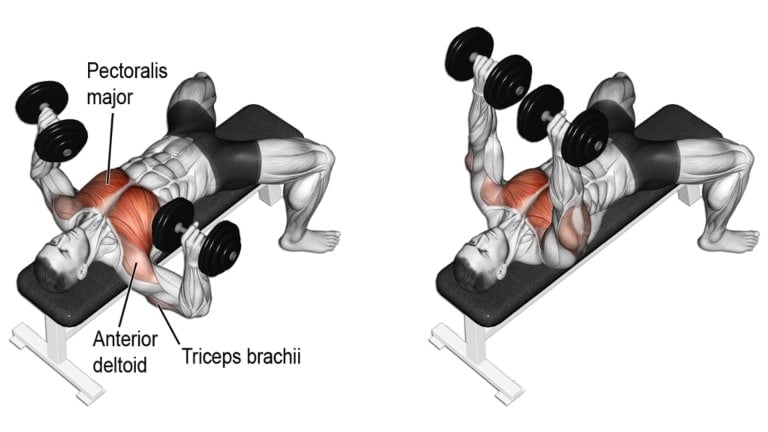
How To Do It
- Lie flat on a bench with your feet firmly planted on the floor.
- Hold a dumbbell in each hand, with your palms facing forward.
- Slowly extend your arms and push the dumbbells straight up above your chest while exhaling.
- Pause for a moment at the top of the movement.
- Then, slowly lower the dumbbells back down towards your chest while inhaling.
Tips
- Don’t allow the dumbbells to collide at the top of each rep – bouncing them together may cause you to lose stability within the shoulder and injure yourself.
- Keep a controlled motion and avoid jerky movements.
- Maintain more tension through the pecs by not locking out the elbows entirely.
2. Incline Dumbbell Press
The incline dumbbell chest press is an upper-body workout that engages the upper pec muscles, the triceps, and the anterior deltoid muscles of the shoulders.
The angle of the adjustable bench in this variation puts more tension on your upper chest muscles than a flat bench press would.
Just like the Incline bench press, the Incline dumbbell press works mostly on the upper pecs, but dumbbells allow a full range of motion and, therefore, are better than the bench press in some ways.
Research shows that doing the Incline bench press at a 30-degree angle is the best way to work on the upper part of your chest.
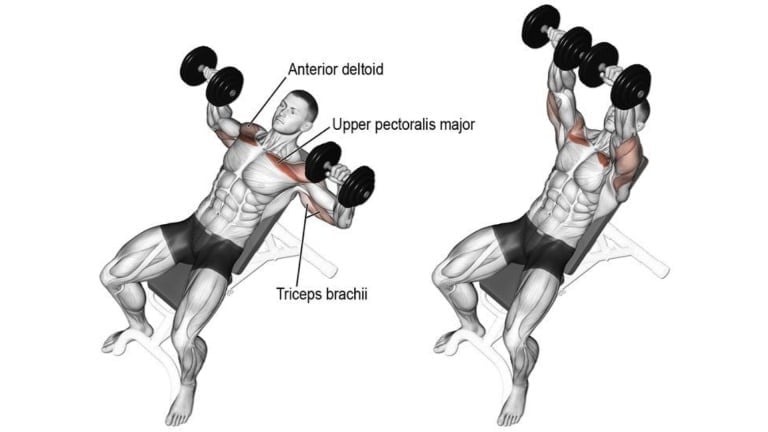
How To Do It
- Adjust the bench to an incline position, typically between 30 and 45 degrees.
- Sit down on the bench with a dumbbell in each hand, resting them on your thighs.
- Clean the dumbbells and lift them straight overhead. Feel a good chest squeeze at the top.
- Lower the dumbbells and feel a good chest muscle stretch at the bottom.
- Repeat the desired number of reps and sets.
Tips
- Perform press in a controlled manner.
- Always use weights that you can handle comfortably.
- Keep your shoulder blades pinched together to ensure the shoulders remain safe.
- Set the bench at about 30–45 degrees inclined. Do not go more upright as the stress shifts more to the shoulders rather than the chest area.
Read More: Upper Chest Dumbbell Exercises For Building A Broad, Strong Pecs
3. Decline Dumbbell Press
The decline dumbbell bench press is an excellent exercise to work your lower chest muscles. It also works the tricep and anterior deltoids.
As the name suggests, you have to use a bench at a declined angle to perform the bench presses.
The angle of the adjustable bench in this variation puts more tension on your lower chest muscles than a flat bench press would.
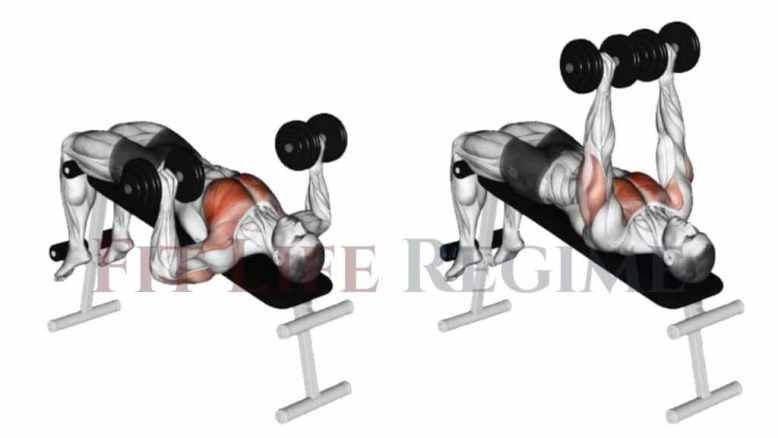
How To Do It
- Adjust the decline bench press angle to 15–30 degrees. And then lie on your back with your face upward.
- Grab the dumbbell in each hand. The grip should be slightly wider than the width of your shoulders.
- Hold the weights above you at shoulder height.
- Now, extend the weights to the top overhead, feeling a good chest muscle contraction.
- Lower the dumbbells to the starting position and feel a good stretch in your lower pecs.
- Repeat the desired number of reps.
Tips
- Make sure you breathe out when you push the weights up and breathe in when you bring them down to your chest.
- Keep your shoulder blades pinched together to ensure the shoulders remain safe.
- Make sure that the weights don’t collide with each other at the top of each rep.
- Ensure you maintain some tension in your abs and don’t allow your lower back to have an excessive arch.
Know More: Lower Chest Dumbbell Exercises To Build Muscle & Definition
4. Dumbbell fly
The dumbbell fly is an isolation exercise that is usually performed after big compound lifts like the bench press and incline press.
It is considered to be the perfect finishing move and a great way to focus on your chest after many pressing exercises.
The dumbbell fly doesn’t require much equipment to perform. You can do dumbbell flies while lying on the floor if you don’t have a bench.
The dumbbell fly is often considered a classic body-building movement, as the exercise aims to isolate the chest for aesthetic purposes.
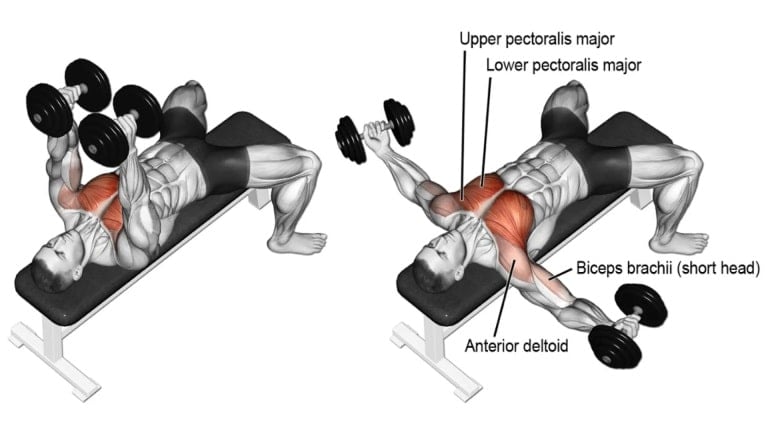
How To Do It
- Lie on the flat bench with your feet flat on the floor.
- Lift your arms straight up from your shoulders and the dumbbells directly over your upper chest.
- Slowly lower your arms to your sides until your wrists reach about shoulder level or slightly above.
- Bring your arms back toward the midline of your body, focusing on using your pec muscles to draw them back together.
Tips
- Don’t let your elbows drop too far when you’re in the start position; they should remain in line with your torso when you’re lying on the bench.
- Don’t let the dumbbells touch as they meet at the top, holding for a second in the contracted position.
- Make sure you keep your elbows bent.
5. Incline Dumbbell Fly
The Incline dumbbell fly exercises are the best exercises that can help to train the chest at various angles and strengthen the upper chest and shoulders.
Having a well-developed upper chest contributes to the fullness of the upper body and has functional benefits.
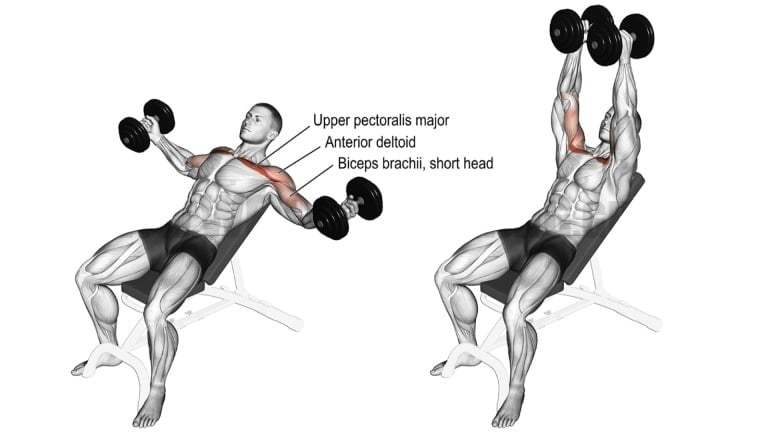
How To Do It
- Set an incline bench at a 30-to-45-degree angle. Lie on the bench with your feet flat on the floor.
- Lift your arms straight up from your shoulders and the dumbbells directly over your upper chest.
- Slowly lower your arms to your sides until your wrists reach about shoulder level or slightly above.
- Bring your arms back toward the midline of your body.
- Do 8–12 reps and 3–4 sets.
Tips
- Set the bench at about 30–45 degrees inclined; don’t go beyond that, as the stress shifts more to the shoulders.
- Maintain control with a 4-second descent, slight pause, and contract with a reverse motion, hold, and repeat.
- Pick a weight that you can control, that’s not too light or too heavy
Read More: Incline Fly: Muscle Worked, Benefits, Alternate
6. Decline Dumbbell Fly
The decline dumbbell chest fly is a strength training exercise targeting the chest, mainly the lower pec muscles.
It is performed on a decline bench, which is set at a downward slope of around 30 to 45 degrees.
The lower chest is one of the harder areas to train because of the lack of variations available and the limited range of motion.
That’s why it’s so important to incorporate these best dumbbell decline fly exercises into your chest workout routine.
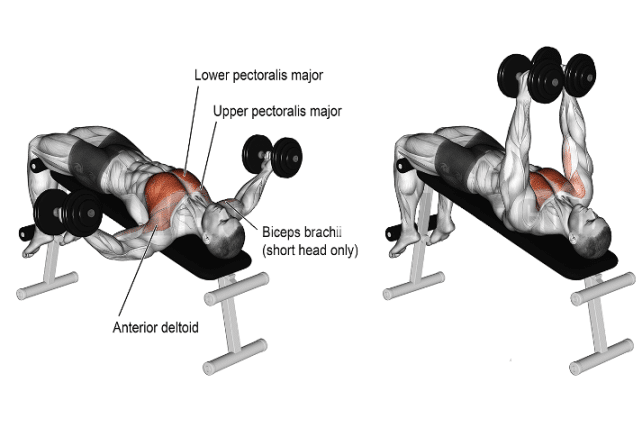
How To Do It
- Set a decline bench at a 30-45 degree angle.
- Lie on the bench with your head at the lower end.
- Hook your feet into the footpad or roller.
- Grab a dumbbell in each hand and lie on your back on a decline bench.
- Extend the dumbbells above your chest.
- Turn the palms to face each other and the dumbbells directly over your upper chest.
- Slowly lower the dumbbells down in a wide arc, keeping your elbows slightly bent until your arms are parallel to the floor.
- Pause briefly, then bring the dumbbells back up to the starting position.
- Do 8–12 reps and 3–4 sets.
Tips
- Use a slight decline, such as 30 degrees.
- Pick a weight that you can control, that’s not too light or too heavy — find what’s right for you.
- Exhale as you lower the dumbbells, and inhale as you bring them back up.
Know More: Decline Fly: Muscle Worked, Benefits, Form
7. Dumbbell Pullover
The dumbbell pullover is a classic bodybuilding exercise that primarily targets the chest muscles.
It also engages the large wing-shaped muscles in the back (latissimus dorsi), the core muscles, and the triceps
They are an excellent addition to your upper body strength routine.
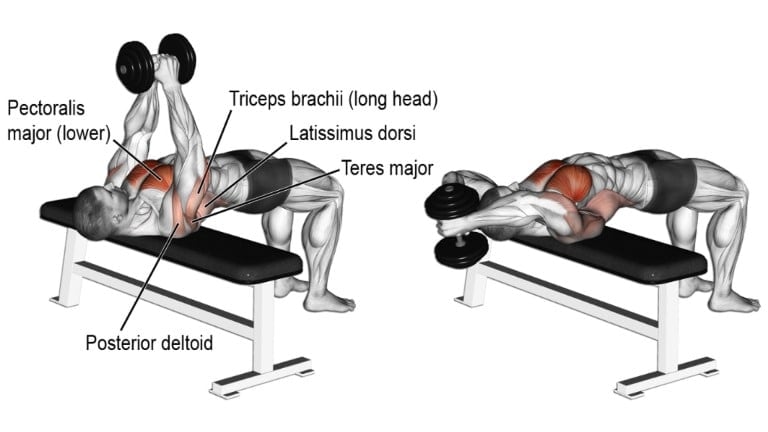
How To Do It
- Lie across on a bench on your shoulders so that your head is hanging.
- Grasp a dumbbell with both hands and get it straight over your chest.
- Lower the dumbbell in an arc slowly, getting a good stretch in your rib cage.
- Lower the dumbbell as far as possible and then raise it back to the starting position.
Tips
- Maintain a slight bend to protect your elbow joints.
- Maximum stretching ensures the greatest expansion of the rib cage.
- Use a weight that challenges you, but allows you to maintain proper form.
- Relax your hips and let them fall, as relaxed hips help in extra expansion.
8. Dumbbell Squeeze Press
The dumbbell squeeze press is one of the most effective chest pressing exercises you can perform to induce functional hypertrophy in the inner body, particularly the inner chest.
As the name suggests, you are performing both squeezing and pressing during the squeeze press exercise.
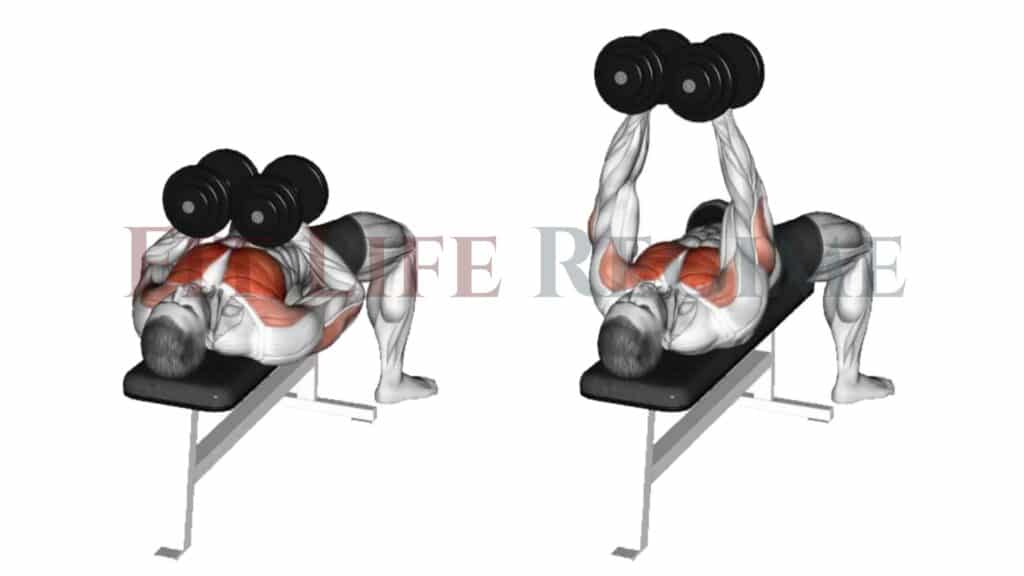
How To Do It
- Take the dumbbells in your hands and lie down on the bench.
- Place the dumbbells together side by side and lift them up over your chest.
- Lower them down together by touching each other, then push the dumbbells back up.
- Repeat for the desired number of repetitions.
Tips
- Breathe out on the way up.
- Maintain more tension through the pecs by not locking out the elbows entirely.
- Keep your movements controlled and avoid jerky motions.
- Always use weights that you can handle comfortably.
Know More: 10 Best Inner Chest Exercises And Workout
9. Incline Bench Dumbbell Pullover
The Incline bench dumbbell pullover is the best exercise to build a strong rib cage and build serratus anterior muscle to build an upper chest and back.
It allows for a wide range of motion, thus providing a deep pectorals and lats stretch.
This exercise is performed lying across on an inclined bench with a moderate dumbbell.
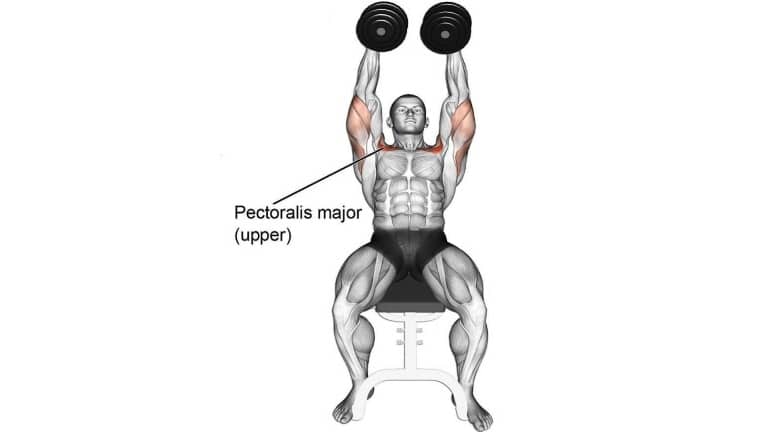
How To Do It
- Set the bench position between 30–45 degrees.
- Now, lie across on an Incline bench.
- Grasp a dumbbell with both hands and get it straight over your chest.
- Lower the dumbbell in an arc slowly, getting a good stretch in your rib cage.
- Lower the dumbbell as far as possible, then raise it back to the starting position.
Tips
- Exhale while you exert.
- Maximum stretching ensures the greatest expansion on the rib cage.
- Vary the position of the bench to hit different angles of the upper chest.
10. Standing Upward Chest Fly
Standing dumbbell chest fly is one of the best chest workouts that you can do at home with dumbbells.
It is a good exercise to target your upper chest. With only a pair of dumbbells, you can make your chest area broader and more developed.
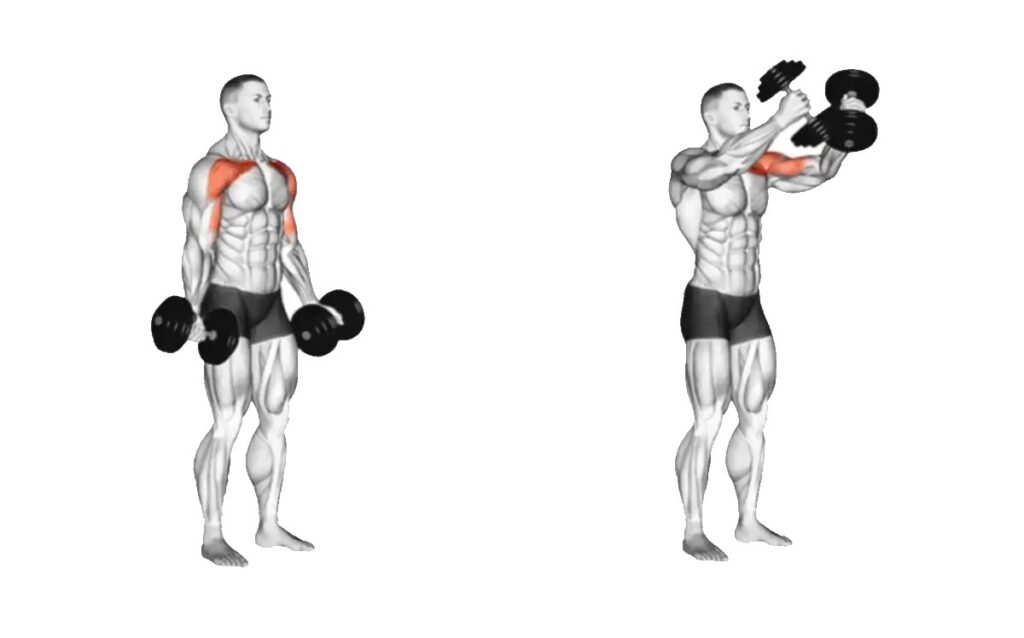
How To Do It
- In a standing position, hold a dumbbell in each hand with your palms facing upward.
- Ensure your feet are shoulder-width apart and your arms down straight in front of your center.
- Extend your arms up and out to the sides, keeping your elbows straight and your arms at chest level.
- Bring them back to the center to finish a single rep.
Tips
- Exhale during the concentric (muscle-shortening) part of the motion.
- Your arms and shoulders will work but most of the work should be done with the pecs.
- Don’t let the dumbbells touch as they meet at the top, holding for a second in the contracted position.
Bonus: Dumbbell Push-Ups
Dumbbell push ups are a variation of the traditional push up exercise. They involve using a pair of dumbbells instead of the hands to perform the push-up movement.
Dumbbell push-ups target the same muscle groups as regular push-ups, including the chest, triceps, and shoulders. Still, they can also provide an additional challenge by requiring additional stability and balance.
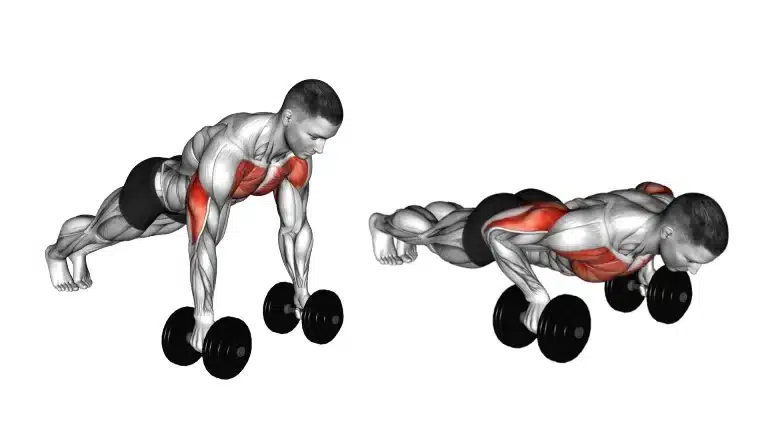
How To Do It
- Grip a dumbbell in each hand and get into a plank position with your palms facing down towards the floor.
- Now raise yourself off the ground, straightening your elbows and your arms, but keep your elbows close to your body.
- Raise until your elbows are near to locked, and pause at the top of the movement for a moment.
- Now lower your body under slow, sustained motion, feeling the motion all the way down until your chest is very close to the ground.
Tips
- Brace your core throughout your chest workout to keep it engaged.
- The elbows should stay close to the body during the exercise to target the chest and triceps effectively.
- It’s important to keep the body in a straight line from head to heels during the exercise.
How to Build a Bigger Chest with Dumbbells
1. Mix Up Your Moves
Think of your chest as it has upper, middle, and lower sections. Target them all for roundness! Here’s the basics:
- Flat Dumbbell Press: The all-around champ.
- Incline Dumbbell Press: Hits those upper pecs.
- Decline Dumbbell Press: Get that defined lower chest.
- Dumbbell Flyes: Stretches things out and makes your chest look wider.
2. Increase Weight Progressively
Muscles stop growing if they get too comfy! Gradually increase those weights as you get stronger.
As your chest strengthens, increase the weight you lift to continue challenging your muscles and promoting growth.
Avoid doing the same exercises and rep ranges and sets every workout.
Instead, vary your routine by changing the exercises, the number of sets and reps, and the weight you use.
3. Focus on form
Bad form = wasted effort, even injuries. Control the weights, don’t let them jerk you around. Get that full stretch and squeeze.
Ensure the full range of motion and control are maintained throughout the movement.
4. Add Variety
It’s a good idea to add a variety of exercises to your chest workout routine to target the muscle from different angles and provide overall muscle growth.
Be smart: don’t limit yourself to dumbbell chest exercises. Get the benefits they offer and use other chest exercises to supplement them when needed.
- Barbell Chest Exercises For Bigger And Stronger Pecs
- Bodyweight Chest Exercises: Beginner To Advance
- 14 Best Cable Chest Exercises And Workout Routine
5. Training Plan As Per Your Goal
- For muscle endurance: Aim for 3–4 sets of 12–15 reps, with moderate resistance.
- For muscle strength: Aim for 3–5 sets of 6–10 reps, with a heavier amount of resistance.
- For muscle hypertrophy (increased muscle size): Aim for 3–4 sets of 8–12 reps, with a moderate to heavy amount of resistance.
It is always best to start with a lower number of reps and sets, and then gradually increase as your strength improves.
Furthermore, it is important to allow for adequate rest between sets, typically 60–90 seconds.
6. Add Intensity
For building chest strength, begin with dumbbell exercises at home or the gym to establish a strong base. However, to truly maximize strength gains, progress to heavy presses with low reps.
The key to chest growth (hypertrophy) is maximizing volume, meaning more time your muscles spend under tension.
Employ intensity techniques like drop sets, supersets, and rest-pause sets to push your muscles further and encourage growth.
7. Give Your Muscles Time to Recover and Proper Nutrition
To support muscle growth, make sure to eat a balanced diet that includes adequate amounts of protein, carbohydrates, and healthy fats.
Allow your muscles time to recover between workouts by taking rest days and getting enough sleep each night.
Dumbbell Chest Workout Plan
This workout contains multiple dumbbell chest exercises that are designed to target all the muscles in your chest and increase overall muscle mass.
This workout plan is a starting point that can be adjusted based on individual fitness levels and goals.
Workout Routine For Beginner
Here’s a beginner chest exercise routine with dumbbells that you can do at home:
| Exercise | Sets | Reps |
|---|---|---|
| Dumbbell Chest Press | 3-4 | 8-10 |
| Dumbbell Push Ups | 3-4 | 8 |
| Dumbbell Fly | 4 | 8-10 |
Routine For Intermediate
| Exercise | Sets | Reps |
|---|---|---|
| Incline Dumbbell Chest Press | 4 | 8-10 |
| Dumbbell Squeeze Press | 3-4 | 10-12 |
| Dumbbell Chest Press | 4 | 10-12 |
| Incline Dumbbell Fly | 3 | 8-10 |
Routine For Advance
Here’s a sample dumbbell-only workout plan for advanced:
| Exercise | Sets | Reps |
|---|---|---|
| Dumbbell Chest Press | 4 | 8-12 |
| Decline Dumbbell Press | 3-4 | 10-12 |
| Incline Dumbbell Fly | 4 | 8-10 |
| Standing Upward Chest Fly | 3 | 10-12 |
| Dumbbell Pullover | 3 | 8-10 |
Know More About Chest Muscles
The chest muscles consist of the pectoralis major and the pectoralis minor.
The pectoral major may conversationally be referred to as “pecs”, “pectoral muscle” or “chest muscle” due to it being the largest and most superficial muscle in the chest area.

Pectoralis major
The pectoralis major is the most superficial muscle in the pectoral region.
The pectoralis major itself comprises two heads, each of which may be worked differently depending on the angle of adduction:
- An upward angle of movement emphasizes the upper, or clavicular head,
- While a lower angle emphasizes the lower or sternal head of the muscle.
The function of the pectoralis major is 3-fold dependent on which head of muscles are involved.
- Flexion, adduction and medial rotation of the arm at the glenohumeral joint
- The clavicular head causes flexion of the extended arm
- The sternoclavicular head causes extension of the flexed arm
Pectoralis minor
The triangle-shaped muscle is located under the pectoralis major, a layer deeper, and draws the shoulder blades down and forward.
FAQs
What are some other dumbbell exercises for the chest besides the bench press?
In addition to the bench press, some other dumbbell exercises for the chest include dumbbell flyes, dumbbell pullovers, and dumbbell push-ups
How heavy should the dumbbells be for chest exercises?
You should choose a weight that is challenging enough to complete the desired number of (8-12) repetitions with proper form but not so heavy that it compromises your form.
Start with a moderate weight and gradually increase it as you become stronger.
How often should I do dumbbell chest exercises?
The number of times you do chest workouts will depend on your goals and fitness level.
However, most people benefit from chest exercises 1–2 times per week, with at least 48 hours of rest between workouts.
Are dumbbell chest exercises suitable for beginners?
Yes, dumbbell chest exercises are suitable for beginners as long as they use proper form and technique.
It’s important to start with basic exercises like dumbbell bench presses and gradually increase the difficulty level as you get stronger.
Takeaways
Dumbbells offer a fantastic way to build a strong, sculpted chest.
Their increased range of motion, targeted muscle activation, and flexible grip options make them superior to barbells for many lifters.
If you want to develop your chest seriously, give this dumbbell-only workout a shot. It’s simple, effective, and delivers fantastic upper-body development.
Commit to a consistent routine, and let the results speak for themselves.
Thanks for reading; enjoy your workout.
Stay Fit, Life a Happy and Healthy Life
References
- Influence of bench angle on upper extremity muscular activation during bench press exercise. Lauver, J. D., Cayot, T. E., & Scheuermann, B. W. (2015). European Journal of Sport Science, 16(3), 309-316. doi:10.1080/17461391.2015.1022605. URL: https://www.tandfonline.com/doi/full/10.1080/17461391.2015.1022605, accessed on 24.08.2020
- Int J Environ Res Public Health. 2020 Oct 8;17(19):7339. Effect of Five Bench Inclinations on the Electromyographic Activity of the Pectoralis Major, Anterior Deltoid, and Triceps Brachii during the Bench Press Exercise.
- Comparative Study Eur J Sport Sci. 2016;16(3):309-16. Epub 2015 Mar 23. Influence of bench angle on upper extremity muscular activation during bench press exercise.

Manish is a NASM-certified fitness and nutrition coach with over 10 years of experience in weight lifting and fat loss fitness coaching. He specializes in gym-based training and has a lot of knowledge about exercise, lifting technique, biomechanics, and more.
Through “Fit Life Regime,” he generously shares the insights he’s gained over a decade in the field. His goal is to equip others with the knowledge to start their own fitness journey.

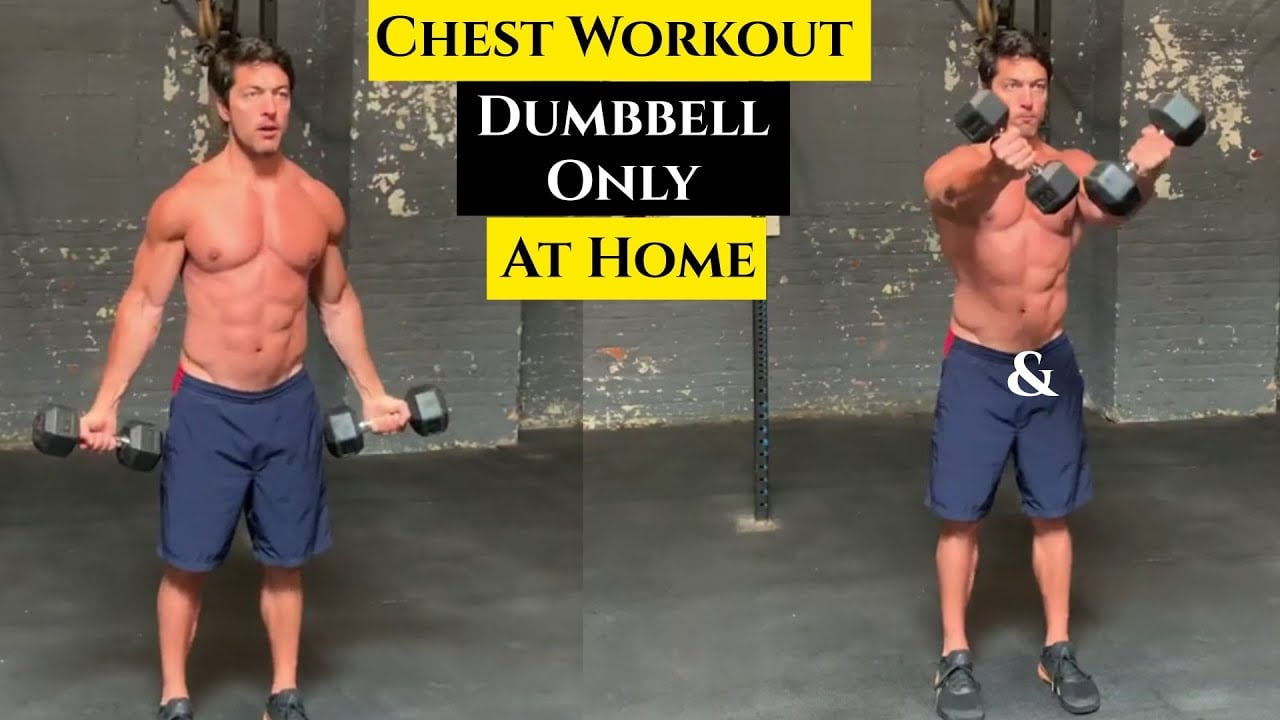
Hello
I was googling for content about Dumbbell Chest Exercises When I came across your excellent resource page.
I just wanted to say that your page helped me, I would have found an excellent resource.
Here it is in case you’d like to check it out https://www.elnodiacademy.com/dumbbell-chest-exercises/
Also, my guide might make a nice addition to your page.
Either way, thanks for putting together your list of resources. Have a great day.